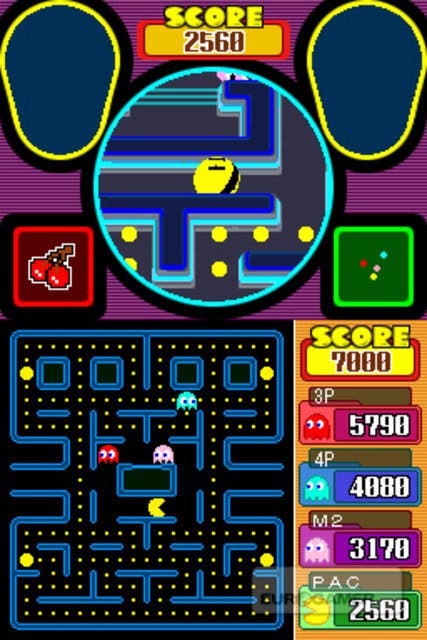Namco Museum DS
And here it is again.
Approaching what amounts to the gaming equivalent of a mid-life crisis, I recently went and paid the talented Retro Chris to make me a bespoke arcade cabinet. It's amazing. Illuminated buttons, coin door, three control panels to take into account vertical and horizontally oriented games, and finished with a Donkey Kong overlay for that special touch. One man's childhood dreams made real, and no, not at all unnecessary and geeky. How dare you. And yes I have seen King of Kong.
But anyway, the point of this increasingly rambling anecdote is that my 26-month-old son is fascinated by it. He eats his breakfast off it, and enjoys Pac-Man [called 'Nack-Nang' by him] so much he hilariously mimics the 'Wacka-Wacka' noises whenever he sees the little yellow blobhead. So when Namco Museum DS arrived for review, he took one look at the box art, held it up to me, giggled and started making more 'Wacka-Wacka' sounds, while informing me of the colours of the ghosts on the back. Needless to say, he enjoys Pac-Man on the DS just as much, mainly to watch the pill-popping fiend get eaten. Repeatedly.
Released on every platform know to man since about 1994 (man, that's retro in itself), the latest Namco Museum is another unapologetic slice of retro bundling which pulls together the usual suspects for yet another outing. Pac-Man, of course, is present and correct, as is Galaga, Galaxian, Mappy, and Xevious, along with some rather less stellar candidates: Dig Dug II, The Tower of Druaga. Two 'secret' games also form part of the package - Super Xevious and the rather pointless Dig Dug II - Old Version), which you can unlock by meeting certain conditions.
Why such obvious well-known titles as Rally-X/New Rally-X, Ms Pac-Man, Pole Position, the original Dig Dug, Pac-Land, Pacmania, Motos and Gaplus couldn't have been thrown in can only be down to a mean spirit rather than cartridge space considerations. One of the recent collections, Namco Museum: 50th Anniversary Arcade Collection, featured 16 titles, so expecting DS owners to be happy with half that seems a little stingy to say the least, but if money's no object, then hey, you'll at least be happy that these are largely perfect ports.

The option to view the game in multiple different ways is a good start. You can choose the top or bottom screen, play them vertically and flip them so the top of the screen is at the left or right, and even in a 1:1 pixel mode that matches the original resolution (even if that means scrolling when you reach the edge of the screen). You can also play them horizontally, both stretched to fit the full screen width or at the correct aspect ratio. It really does cater for any preference, and means that pedants like me can play their old favourites as nature intended.
Although the front-end fonts of each game look a little 'tweaked', shall we say, in-game it's all been left alone, and looks as close to the real thing as is possible on the small screen. Naturally, there are a few obvious compromises you have to take into account/endure when playing them. Horizontally, you're losing maybe 40 percent of the screen area, while playing vertically suffers from the need to position your hands rather oddly when using games requiring a fire button. So, while playing Pac-Man is absolutely fine vertically, Galaga and Galaxian feel unnatural, so it's a trade-off you have to get used to if you want them to look their best. There's also the option to play each game in Smooth or Sharp mode, but the former makes everything needlessly fuzzy, so definitely avoid that one. Elsewhere, you also get the chance to meddle with button configurations and the dip switches (with the stylus itself on a picture of the board, no less!), which set all manner of variables from difficulty and number of lives to when bonus lives are awarded. There are even some 'hardcore' settings, should you feel the need.
Elsewhere, there's scant attempt to cater to the 'Museum' element of the package, with a few measly lines of text to remind people of their legacy. A few Japanese flyers, instruction cards, postcard and a picture of the system board make the cut (if you're lucky), but it's half-hearted in the extreme, though the DS is a terrible means of looking at artwork anyway. On the plus side you do get a music player in order to play all the various ditties and sound effects in every game, but it hardly makes up for the lack of care devoted to the project. If this is a museum, it's a pretty shonky one where the curators snuck out the back for a smoke.



